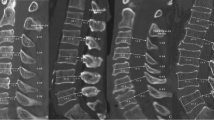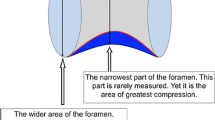Summary
Detection of subtle osseous changes on plain film roentgenograms of the cervical spine is essential in expediting the evaluation of suspected intraspinal tumors. It is our experience that the earliest osseous changes in such cases involve thinning or erosion of the adjacent pedicles and/or lamina and a subsequent increase in the oblique diameter of the cervical spinal canal. A statistical model is established which accurately describes the normal cervical vertebral column in terms of its spinal canal size (sagittal and oblique diameters) as well as pedicle and lamina thickness. Data was obtained from a series of 86 normal exams. Six surgically proven cases of cervical intraspinal tumors were analyzed using this model. Variations from expected normal values reveal statistically significant osseous changes involving thinning of the lamina and increased oblique diameter of the spinal canal, while the sagittal diameter of the canal remains normal. Because of these findings we feel that oblique cervical spine films should be included in the initial evaluation of neural canal tumors.
Similar content being viewed by others
References
Camp JD (1938) The roentgenologic localization of tumors affecting the spinal cord. AJR 40:540–544
Elsberg CA, Dyke CG (1934) The diagnosis and localization of tumors of the spinal cord by means of measurements made on the X-ray films of the vertebrae and the correlation of clinical and X-ray findings. Bull Neurol Inst NY 3:359–394
Boijsen E (1954) The cervial spine in intraspinal expansive processes. Acta Radiol 42:101–115
Guidetti B, Fortuna A (1975) Differential diagnosis of intramedullary and extramedullary tumors. In: Vinken PJ, Bruyn GW (eds) Handbook of clinical neurology, Part I: Tumors of the spine and spinal cord. North-Holland, Amsterdam, pp 51–75
Dolan KD (1977) Expanding lesions of the cervical spinal canal. Radiol Clin North Am 15:203–214
Yosefzadeh DK (1981) Reversed funneling and fusiform configuration of the bony cervical spinal canal in children-normal anatomic variants. Presented at the 24th Annual Meeting of the Society for Pediatric Radiology, March 1981
McAfee PC, Levinsohn EM, Ulbrich CG et al (1981) Computed tomography in degenerative spinal stenosis: the value of multiplanar reconstruction. Scientific exhibit at the 67th Annual Meeting of the Radiological Society of North America, November 1981
Author information
Authors and Affiliations
Rights and permissions
About this article
Cite this article
Manaster, B.J., Moccia, W.A. & Quisling, R.G. Development of a mathematical model of the cervical spinal canal and its use in detecting early pathologic changes. Neuroradiology 23, 167–173 (1982). https://doi.org/10.1007/BF00342536
Received:
Issue Date:
DOI: https://doi.org/10.1007/BF00342536




